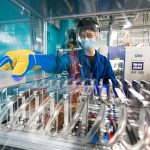
Researchers also employed X-ray diffraction at another synchrotron – SLAC’s Stanford Synchrotron Radiation Lightsource – which attempted to recreate the conditions present in a battery, and additionally provided a many-particle battery model.
All three forms of data were combined in a format to help the machine-learning algorithms learn the physics at work in the battery.
While typical machine-learning algorithms seek out images that either do or don’t match a training set of images, in this study the researchers applied a deeper set of data from experiments and other sources to enable more refined results.
The study benefited from an ability to single out the chemical states of about 100 individual particles. Each selected particle was imaged at about 50 different energy steps during the cycling process, for a total of 5,000 images.
The data from ALS experiments and other experiments were combined with data from fast-charging mathematical models, and with information about the chemistry and physics of fast charging, and then incorporated into the machine-learning algorithms.
“Rather than having the computer directly figure out the model by simply feeding it data, as we did in the two previous studies, we taught the computer how to choose or learn the right equations, and thus the right physics,” says Stanford researcher Stephen Dongmin Kang.